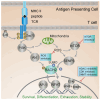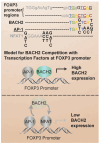BACH2: The Future of Induced T-Regulatory Cell Therapies
- PMID: 38891024
- PMCID: PMC11172166
- DOI: 10.3390/cells13110891
BACH2: The Future of Induced T-Regulatory Cell Therapies
Abstract
BACH2 (BTB Domain and CNC Homolog 2) is a transcription factor that serves as a central regulator of immune cell differentiation and function, particularly in T and B lymphocytes. A picture is emerging that BACH2 may function as a master regulator of cell fate that is exquisitely sensitive to cell activation status. In particular, BACH2 plays a key role in stabilizing the phenotype and suppressive function of transforming growth factor-beta (TGF-β)-derived human forkhead box protein P3 (FOXP3)+ inducible regulatory T cells (iTregs), a cell type that holds great clinical potential as a cell therapeutic for diverse inflammatory conditions. As such, BACH2 potentially could be targeted to overcome the instability of the iTreg phenotype and suppressive function that has hampered their clinical application. In this review, we focus on the role of BACH2 in T cell fate and iTreg function and stability. We suggest approaches to modulate BACH2 function that may lead to more stable and efficacious Treg cell therapies.
Keywords: BACH2; FOXP3 stability; T lymphocytes; inducible regulatory T cells.
Conflict of interest statement
The authors declare no conflict of interest.
Figures




References
-
- Kometani K., Nakagawa R., Shinnakasu R., Kaji T., Rybouchkin A., Moriyama S., Furukawa K., Koseki H., Takemori T., Kurosaki T. Repression of the transcription factor Bach2 contributes to predisposition of IgG1 memory B cells toward plasma cell differentiation. Immunity. 2013;39:136–147. doi: 10.1016/j.immuni.2013.06.011. - DOI - PubMed
Publication types
MeSH terms
Substances
Grants and funding
LinkOut - more resources
Full Text Sources
Research Materials

